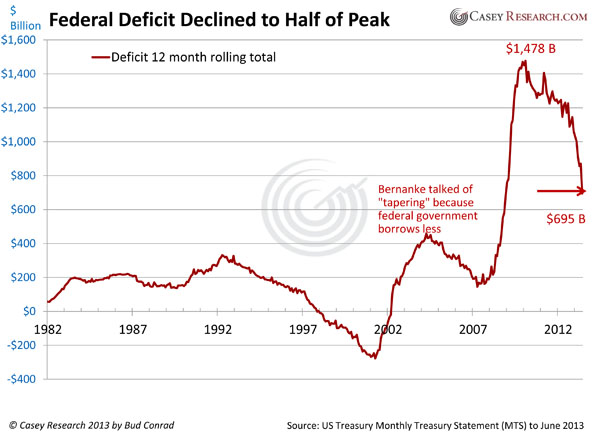Bonds & Interest Rates
Despite Declining Deficit, Foreigners Aren’t Bailing Us Out, So the Fed Will Keep QE Going
The basic imbalance driving our economy is the government deficit, which spun out of control as a result of the Credit Crisis of 2008/9. But the sequester, improving tax base, lower interest rate, and elimination of stimulus spending have caused the big government deficit, while still extreme, to drop to half its previously nosebleed levels.

…..read & view more charts HERE

The white flag of surrender hasn’t quite been raised, but the war for the Canadian investor looks all but over…..
CLICK HERE to read the complete article
This is an automatically generated default main template – please do not edit.
Please note: the main template does not contain any fields.

 Have the quantitative easing measures / stimulus by various central banks done an irreversible damage to the long-term prospects of global economy, markets (equity and commodity)? Why / why not?
Have the quantitative easing measures / stimulus by various central banks done an irreversible damage to the long-term prospects of global economy, markets (equity and commodity)? Why / why not?
Marc Faber : There are people believe that Ben Bernanke and other central bankers have saved the world’s financial system. I am not saying that they are wrong but I am suggesting that the crisis occurred in the first place because of the expansionary monetary policy – principally by the US Federal Reserve since the 1990’s.
In other words, each time there was a crisis – be it S&L (savings and loans) crisis, LTCM Hedge Fund crisis, Mexican peso crisis which is also known as the Tequila crisis – ahead of Y2K, monetary policies were eased and liquidity injection occurred. And then we had the Nasdaq collapse in the year 2000.
The US Federal Reserve then again embarked on extremely expansionary monetary policy, which created a gigantic credit bubble and home prices surged.
When this came to an end, that’s when the crisis actually happened. Had the US Fed not pursued very expansionary monetary policies and paid attention to excessive credit growth, there would have been no crisis.
The Asian countries are less likely to Confiscate The Gold than Western Countries
SMN: Governments around the world are laying down the pieces for bail-in plans. A lot of our audience is worried that their precious metals will be taken away from them, even if they’re stored outside of the banking system. Do you think physical gold and silver are protected from confiscation if they’re held outside the banking system and stored at a respected facility, like Brink’s?
Marc Faber : Yes, that’s a good question. I wonder what will happen one day. Let’s take the worst-case scenario. We have either a social unrest, a revolution, or war. Governments decide, “Oh, the price of gold is going up substantially, let’s take it away from people.” In other words, you expropriate it. I think it will, at that stage, not matter very much where you hold your gold, except it may matter where you hold your gold in terms of sovereign state. My sense is that the Asian countries are less likely to take the gold away than Western countries.
– in Sprott money News Interview : Click Here to watch the full interview >>>>>>
The Central Banks dont have all the GOLD they claim they have
……read the entire article HERE
Worldwide, You shouldn’t Believe Governments, period
……read it all HERE
The Chinese Economy is Growing at maximum 4 percent per annum, not 7.5 percent or 7.7 or 7.6 percent.
…..read it all HERE
Marc Faber : I think that the Fed is completely clueless
…..read it all HERE

 Detroit’s bankruptcy cites more than $18 billion in debts, but the city has one asset that could help its balance sheet considerably: its art collection.
Detroit’s bankruptcy cites more than $18 billion in debts, but the city has one asset that could help its balance sheet considerably: its art collection.
The Detroit Institute of Arts has one of the nation’s oldest and most valuable public art collections, with pieces by Vincent van Gogh, Henri Matisse and Rembrandt van Rijn. Experts say the collection is easily worth more than $1 billion.
In May, the city’s emergency manager, Kevyn Orr, sparked an uproar when he requested an inventory of the collection. Orr’s spokesman, Bill Nowling, told reporters that while Orr doesn’t want to sell the collection, all of the city’s assets had to be valued and considered as part of its financial plan.
(Read More: Detroit joins list of failed US towns)
“We have to look at everything on the table,” he told the Detroit Free Press in May, adding that the city has a “responsibility to rationalize all the assets of the city and find out what the worth is.”
Pamela Marcil, a spokeswoman for the Institute, said a team from Christie’s auction house visited the museum in May, though their purpose remains unclear. While Christie’s requested to send a larger team in June, it’s unclear whether the second group ever visited the Institute, the spokeswoman said.
Christie’s declined comment.
Local cultural supporters and museum groups say selling any of the collection would be a crime. The Institute issued a statement after the bankruptcy filing that said it is “disappointed that the emergency manager determined it was necessary to file for bankruptcy.” It added that the “collection is in trust for the public and we stand by our charge to preserve and protect the cultural heritage of all Michigan residents.”
(Read More: What’s Next for Detroit? Long Court Battle)
At the moment, it appears the state agrees. Michigan Attorney General Bill Shuette said, in a statement, the Detroit Institute of Arts’ collection is held by the city in a charitable trust for the people of Michigan. He said “no piece in the collection could be sold, conveyed or transferred to satisfy debts or obligations.”
What’s more, experts in art law say that many of the pieces in the Institute were bequests from wealthy collectors that could contain restrictions on their sale.
Still, bankruptcy experts said the collection’s fate could be determined by a bankruptcy court. While creditors can’t force the city to sell any particular asset under Chapter 9, they can reject a plan that they conclude doesn’t include sufficient asset sales or payments.
“We can’t ask for the art to be sold, but we can ask for more asset sales and then it’s up to the city,” said one attorney representing Detroit’s creditors.
(Read More: Detroit bankruptcy could hit millions of retirees)
While the museum, which is expected to draw more than 500,000 visitors this year, is owned by the city and is funded with support from a special tax from three counties that’s expected to raise about $23 million a year for the next 10 years. Residents who pay the tax get free admission.
Among the museum’s top works is a Van Gogh “Self Portrait” from 1887. Experts said it could be worth more than $100 million. A Van Gogh self-portrait sold at auction in 1998 for $71 million, but prices for top art works have soared in the past decade.
(Read More: Art Is the Next Gold: Novogratz)
The museum’s other classics include Rembrandt’s “The Visitation,” James Whistler’s “Nocturne in Black and Gold,” and “The Wedding Dance” by Pieter Bruegel the Elder, as well as works by Claude Monet, Matisse and Caravaggio.
This story was originally published by CNBC.
Read more: http://www.businessinsider.com/bankrupt-detroit-could-sell-its-billion-dollar-art-collection-2013-7#ixzz2ZwXp7bHv

 The Fed wants to keep long-term yields depressed, but its policies are riddling the market with risk.
The Fed wants to keep long-term yields depressed, but its policies are riddling the market with risk.
FORTUNE — Last Wednesday, at a conference in Cambridge, Mass., Ben Bernanke sought to clarify the statements that shocked the markets just three weeks earlier. This time, the Federal Reserve Chairman reassured his vast, anxious audience that his pledge to start shrinking the Fed’s $85 billion in monthly purchases of long-term bonds, the latest version of “quantitative easing,” or QE3, didn’t mean that the Fed was abandoning the easy money policies that have cheered the markets for four years. The Fed would support the economy with “highly accommodative monetary policy,” intoned the Chairman, “for the foreseeable future.”
…..read more HERE












